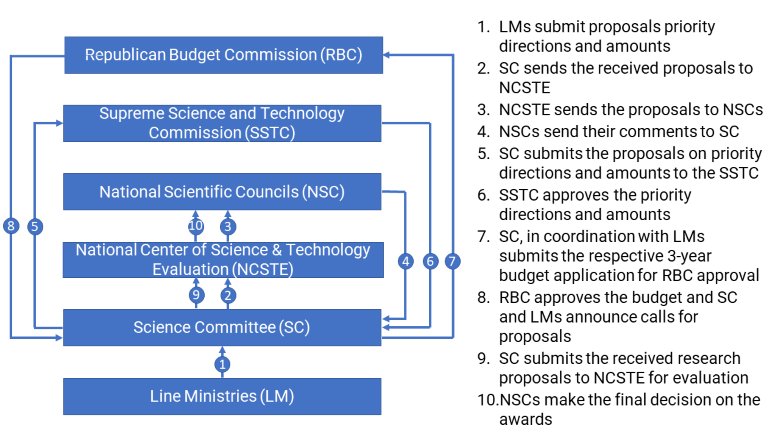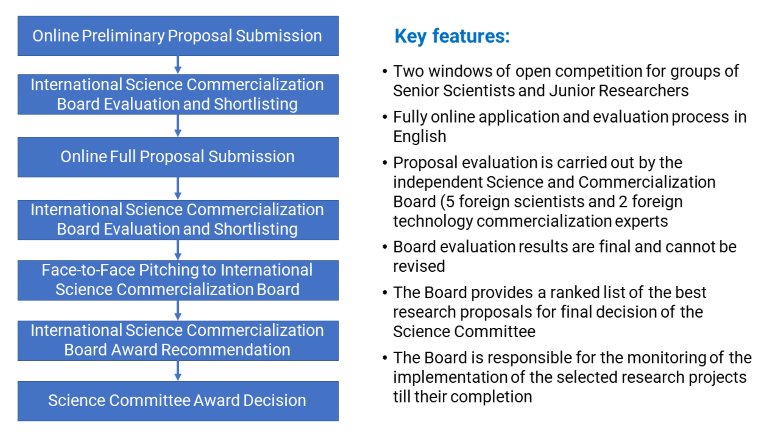Over the past decade, Kazakhstan’s innovation system—the network of institutions, firms, and people that boost the flow of information and technology—has become considerably more market driven. That has been partially achieved thanks to two World Bank-supported projects, Technology Commercialization Project (TCP, 2008-2015) and the ongoing Fostering Productive Innovation Project (FPIP), that have promoted a model for technology commercialization adopted by the Government of Kazakhstan. This model emphasizes competitive research and development (R&D) funding and support for the commercialization of research that drives new innovations and creates jobs.
Shift to Competitive R&D Funding
TCP piloted the first competitive R&D grant program with a fully digitalized application process in English and established the first International Science and Commercialization Board (ISCB) responsible for the independent selection of R&D projects for funding. Every aspect of this grant program disrupted the existing system of public financing of R&D (Figure 1), in which line ministries signed off on proposals while the National Scientific Councils (NSCs), consisting of local scientists, could in practice ignore the evaluation results of the National Center for Science and Technology Evaluation (NCSTE) that engaged foreign experts. In addition, neither the NCSTE nor the NSCs evaluated research proposals for the potential for commercializing technology. This system, therefore, was cumbersome, created direct conflicts of interest and completely ignored commercialization.
Figure 1. National system of grant financing
In contrast, TCP implemented a streamlined selection mechanism that followed best international practices (Figure 2). This mechanism involved only two bodies: (1) the International Science Commercialization Board (ISCB), created with the support of the World Bank, that screens and shortlists applications and (2) the Science Committee that makes the final decision based on board recommendations. These two bodies oversaw grant programs that had two separate application streams – for senior scientists and for junior researchers – available fully online and in English. ISCB’s evaluations were independent and final, and served as a basis for the Science Committee to make a final decision on the list of winners, with ISCB responsible for regular monitoring of selected projects until their completion.
Figure 2. Grant financing system under World Bank-financed projects
The new process resulted in first-time awards to numerous teams outside of public research institutes and to young researchers carrying out their R&D projects, who no longer had to seek the patronage of senior tenured scientists or the management of their research institutes. Moreover, these researchers fully owned their intellectual property. The results were stunning both in terms of academic excellence and commercialization. On average, international peer-reviewed publication per researcher was 56% higher among TCP beneficiaries as compared to the national average in 2014 and 2015, and the commercialization rate of the R&D projects supported by the TCP reached 30%.
Shifting Beneficiaries’ Mindsets
Project beneficiaries not only received funding for their research, but also learned new, internationally-accepted practices of R&D and received hands-on experience in technology commercialization. Mikhail Nauryzbaev, a TCP beneficiary reflected: “Before participating in the project, I thought that it is the government and businesses that are not doing their part to ensure there are practical applications of R&D in Kazakhstan, and I, as a scientist, have done my part. The TCP project showed me that there is a lot more researchers would need to consider to ensure the success of their invention. I also realized that such endeavors require a team of various professionals, including experts in business and marketing.”
Despite the challenges of TCP’s implementation, the first cohort of innovation policy professionals was formed, armed with experience in dismantling the old rules while developing and testing new ones. Active across the innovation ecosystem, all of these professionals were exposed to cutting edge knowledge and experience from CRDF Global and Texas IC2. As Abdilda Shamenov, Chairman of the Science Fund of the Republic of Kazakhstan and a TCP alumnus, stressed: “We learned how to identify the commercialization potential of R&D projects and help others to successfully bring their inventions to the market.” After TCP concluded, these alumni established the Alliance of Technology Commercialization Professionals, providing technology commercialization services and capacity building throughout the country.
Institutionalizing a New Approach
Building a critical mass of people with market-driven mindsets in the innovation ecosystem continued under the FPIP, which embarked on more complex activities, such as building long-term technology consortia, inclusive innovation consortia, and setting up an early-stage venture capital fund.
Again, FPIP funded projects were at the forefront of national R&D. With less than 2% of all researchers employed in the country, FPIP-supported teams filed 25% of all Patent Cooperation Treaty (PCT) patent applications in Kazakhstan in 2020.
As more and more people involved in the projects became prominent players in the national innovation ecosystem, TCP and FPIP pilot programs were adopted as standard governmental policy instruments. For example, the R&D commercialization grant programs of the Science Fund have been upgraded based on TCP and FPIP practices. And the national innovations agency QazInnovations has recently implemented the technology consortia program initiated by the FPIP.
“FPIP experience helped me understand the real challenges of building and strengthening the industry-science linkages in Kazakhstan and the importance of continuously working on closing information gaps and fostering reliable communication between stakeholders. The government is committed to progressively strengthening national innovation and industrial policy. Building trust and improving the flexibility of policy tools are key to success,” said Ilyas Ospanov, Deputy Minister of Industry and Infrastructure Development, who was part of the FPIP project team for several years. When the change of mindset on the government policy side meets a complementary shift in mindset on the innovation supply side, systemic change becomes self-amplifying.
Adoption of competitive grant funding mechanisms has made the national R&D funding programs more transparent and improved the quality of R&D project proposals in terms of their scientific merit and commercialization potential. A market-driven innovation ecosystem supported by TCP and FPIP has become an important factor of Kazakhstan’s regional leadership in science, technology, and innovation—critical for driving growth and maintaining competitiveness in our rapidly digitizing global economy.



